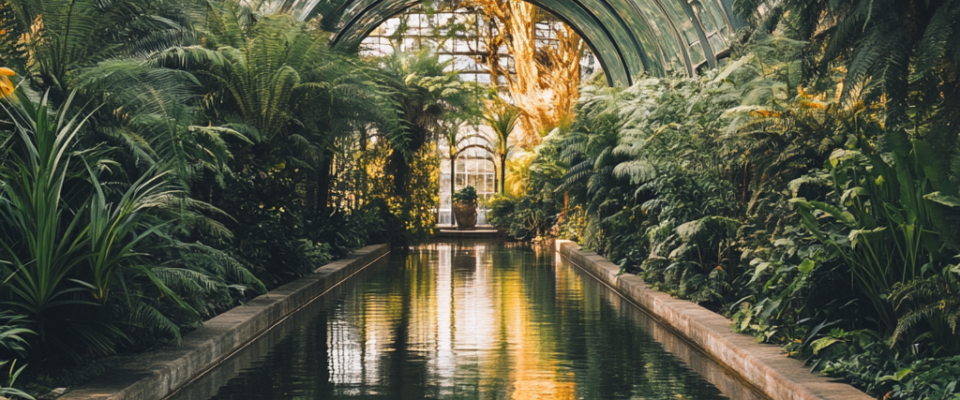The origin of botanical gardens in Ancient civilizations
The history of botanical gardens begins with ancient civilizations such as Egypt, Mesopotamia, China and Persia. One of the first examples of such gardens is the famous Hanging Gardens of Semiramis in Babylon, which are one of the seven wonders of the world. These gardens were not only a place of relaxation, but also a demonstration of the ruler’s power and wealth. Ancient gardens often served as a symbol of the power and harmony of man with nature.
In ancient Egypt, there were gardens that included medicinal and aromatic plants. The Egyptians actively used herbs for medicine and religious rituals, and therefore knowledge about plants was of great importance. Chinese imperial gardens were also an important element of culture and art. Their structure has been thought out in such a way as to create an ideal microclimate for studying plants and creating unique flavors.
Medieval monastery gardens and their role in botany
In the Middle Ages, botanical knowledge was mainly preserved in monasteries, where monks were actively engaged in the study and cultivation of plants. Monastery gardens were the forerunners of modern botanical gardens, as they played an important role in preserving and transmitting knowledge about plants and their medicinal properties.
The monks grew medicinal plants to create medicinal infusions and ointments. Such gardens, known as “hortus conclusus” (enclosed gardens), were not only used for the production of medicines, but also served as a place for meditation and spiritual enrichment. They included various herbs, flowers and even vegetables, which made them both useful and aesthetically appealing. This was an important stage in the history of botanical gardens, as the monastery gardens became the first organized collections of plants collected for systematic study and use.
The Renaissance: the formation of botanical gardens in Europe
With the advent of the Renaissance, interest in botany increased, and European universities began to create the first official botanical gardens. One of the most famous was the Botanical garden of the University of Pisa in Italy, founded in 1543, as well as the garden of Padua, which began work in 1545 and is the oldest existing today.
These gardens were created as training grounds for medical students studying pharmacology and plant properties. Since medicine at that time was closely connected with herbalism, the university botanical gardens quickly became scientific centers where plants from different parts of the world were collected and classified. During this period, the foundations of modern botany and plant systematics were laid.
Colonial times and the development of botanical gardens around the world
With the development of geographical discoveries and colonization, botanical gardens began to spread all over the world. Seafarers and explorers brought exotic plants from distant countries, which were then planted in the botanical gardens of Europe. It was a time of active exchange of plant crops between continents.
The British Empire, in particular, played a significant role in the creation of botanical gardens in colonies such as India, Australia and the Caribbean Islands. The Royal Botanic Garden at Kew Gardens in London has become a center for acclimatization and study of plants brought from the colonies. These plants were studied and then used in medicine, agriculture and perfumery. Botanical gardens became a kind of “banks” of genetic material in which rare and valuable plant species were preserved.
Botanical gardens in the XIX and early XX centuries: scientific centers and public spaces
In the 19th century, the botanical gardens underwent significant changes. They turned into important scientific institutions where research was conducted on plant breeding, the study of their physiology and genetics. During this period, the systematic creation of herbariums and seed collections also began, which helped significantly expand knowledge about the world’s plant diversity.
Botanical gardens became places where scientists could observe the growth of plants in various conditions and develop new methods of growing them. This was also the time when the gardens became accessible to the general public. They began to perform not only a scientific, but also an educational function, attracting visitors and popularizing botanical knowledge among the population. Many of these gardens have become the favorite vacation spots of the townspeople, who enjoyed the beauty of the natural landscapes.
Modern botanical gardens: biodiversity conservation and education
Today, botanical gardens are essential for the conservation of biodiversity and the protection of endangered plant species. They serve as vital centers for environmental education and sustainable development while also acting as platforms for scientific research. By collaborating with international organizations and scientists worldwide, modern botanical gardens work diligently to preserve rare and endemic species.
Key Roles of Modern Botanical Gardens:
- Preservation of Biodiversity: Botanical gardens play a crucial role in safeguarding endangered plant species and maintaining genetic diversity.
- Environmental Education: They serve as educational centers, offering programs and seminars for all age groups to enhance public understanding of the significance of plants and their contributions to planetary health.
- Scientific Research: Botanical gardens are involved in various scientific studies, contributing to the understanding of plant biology, ecology, and conservation methods.
- International Collaboration: Many botanical gardens partner with global organizations and researchers to develop strategies for conserving rare and endemic plant species.
- Ecosystem Restoration: They actively participate in programs aimed at restoring ecosystems and cultivating endangered plants, ensuring the health of natural environments.
- Creation of Genetic Banks: Botanical gardens establish genetic banks to preserve plant genetic material, which can be crucial for future research and restoration efforts.
Questions and Answers
The origins of botanical gardens can be traced back to ancient civilizations such as Egypt, Mesopotamia, China, and Persia. Notable examples include the Hanging Gardens of Semiramis in Babylon and gardens in ancient Egypt that featured medicinal and aromatic plants.
Medieval monastery gardens, known as “hortus conclusus,” played a crucial role in preserving botanical knowledge. Monks cultivated medicinal plants for creating infusions and ointments, and these gardens served as early organized collections of plants for systematic study.
The Renaissance sparked a renewed interest in botany, leading to the establishment of the first official botanical gardens in European universities, such as the Botanical Garden of the University of Pisa and the Garden of Padua. These gardens served as training grounds for medical students and became scientific centers for plant classification and study.
During the colonial era, botanical gardens expanded globally as explorers brought exotic plants from various countries to Europe. The British Empire significantly contributed to this expansion, establishing botanical gardens in colonies like India and Australia, which became centers for the study and acclimatization of these plants.
Modern botanical gardens are vital for biodiversity conservation, environmental education, scientific research, and international collaboration. They play a significant role in preserving endangered species, promoting sustainable resource use, restoring ecosystems, and serving as symbols of environmental responsibility for future generations.

